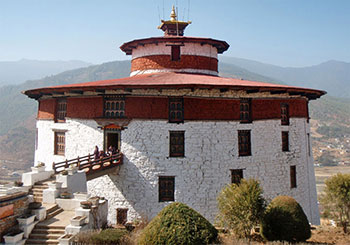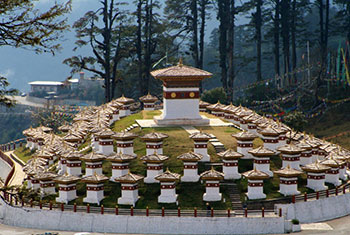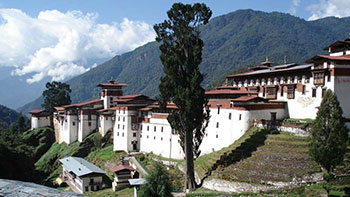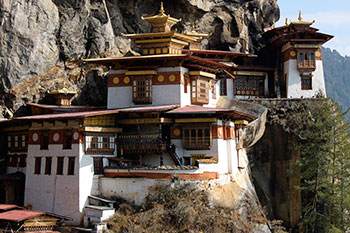Bhutan Buddhist Tour
Duration : 10 Nights / 11 Days
Destinations : Paro – Thimphu - Punakha - Phobjikha Valley - Bumthang – Wangdue - Paro - Thimphu
Buddhism is the soul of Bhutan. Experience the soul of the last Buddhist kingdom with a trip through the monasteries and rich spiritual traditions of the country. Here, Mahayana Buddhism is followed with great zeal. Explore the rich heritage of Buddhist traditions and explore your hidden self with Bhutan Buddhist Tour.
Day 1: Arrival at Paro
After this, continue to Rinpung Dzong, which means fortress of the heap of jewels. This particular complex has the administrative and religious headquarters for the Paro district. Post lunch, take a short drive to Drukgyel Dzong, a historic landmark in ruins. Bhutanese defeated the Tibetan invasions and drove them back to their wilderness. From this place, the majestic peak of Jumolhari, the 'Mountain of the Goddess' can be admired on a sunny day (Alt. 7,329 m /24,029 ft.). On the way back, don't miss the 'Kichu Lhakhang', the oldest and the most sacred shrine of Bhutan built in 8th century by Tibetan Monarch Songtsen Gampo.
Day 2: Paro to Thimphu.
Paro to Thimphu. After breakfast transfer to Thimphu. Check into hotel on arrival at Thimphu and visit Bhutan National Bank and Bhutan General Post Office for currency exchange and then you can get an opportunity to purchase exquisite collector Bhutanese stamps. In the afternoon visit the National memorial chorten which was built in 1974 in Memory of the third king; the Folk Heritage museum, arts and crafts, and visit Chang Gangkha Monastery. In the evening you can walk in the town and then Dinner at Bhutan Kitchen.
Day 3: Thimphu to Punakha.
Day 4: Punakha to Phobjikha valley.
After breakfast, visit the Chimed lhakhang, the fertility temple of Saint Drukpa Kuenley known popularly as 'the divine madman'. Then take a hike to the Wangduephodrang Dzong, which sit majestically on a steep ridge over looking the highway those forks to the east and south of the country. Then drive to Phobjikha valley, on the way visit one of the most ancient monasteries in Bhutan that was resurrected by the 9th Gangtey Tulku Rimpoche.
Day 5: Phobjikha-Bumthang.
Post breakfast, we will move towards Bumthang passing over Pele la (11,000 ft) And Yotungla pass. Here we get our first glimpse of the Black mountains. High Himalayan Mountains Such As Jumolhari are in view amidst hundreds of prayers flags; blessings abound. As we continue onwards we begin to get our first glimpse of the incredible massive dzong - Trongsa dzong; an architectural Wonder! Trongsa medieval watchtower and the great Mangde chu (river) enhance Trongsa dzong in its exceptional beauty and grandeur. We now stop to visit Trongsa dzong; ancestral home of the royal family. Built in 1648 ad it is presently the administrative seat of the district and the home of the monastic school. Built at split-levels on a narrow spur, the dzong offers magical wonder. The watchtower, located directly above the dzong, has on display many interesting armors and other weapons of war used by ancient warriors. Continue onwards to Jakar.
Day 6: Bumthang Sightseeing.
The Bumthang valley is one of the most beautiful valleys in the whole of Bhutan. It is also the religious heartland where many saints and masters meditated leaving their imprints as sacred places of worship and pilgrimage Tales of Pedmasambhava dominate these holy shrines. In the morning visit, Jampa Lhakhang which is built by Tibetain King Songtshen Gempo in 7th century and then drive to Kurji Lhakhang were body imprints of Guru Rimpoche remain s preserved upon a rock. Then short hike to Tamzhing Monastery. If the weather is clear, you will enjoy the view of green valley, dotted with hundreds tempals, thousand flags and beautiful chamkhar river flow through the valley. The valley is also known as the mini Switzerland of Bhutan. You will be driven to Swiss Guest House for an English lunch, prepared by the guest house owner himself. Later in the day, you'll be taken to the Jakar Dzong and the old residence of Wangdicholling.
Day 7: Continue sightseeing.
Day 8: Bumthang To Wangdue.
A drive from Bumthang towards the west, taking around seven hours sees you in Wangdue. Enroute stop for lunch and photographs on the way when you come across good spot for your pictures.
Day 9: Wangdue to Paro via Thimphu.
You will be driven to Thimphu today, for shopping and lunch. Continue onwards to Paro.
Day 10: Excursion to Tiger Nest.
Day 11: Departure
After breakfast, bid farewell to your guide and be transferred to the airport for flight.
